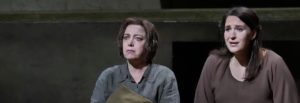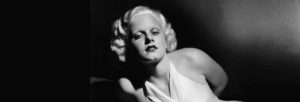Karol Szymanowski’s 1926 King Roger was the sleeper hit of SFO’s season, not so much for its weird, mystical theme and feeble libretto but because the music is powerfully effective and Evan Rogister handled the shimmering, richly expressionistic orchestral writing with consummate skill. The choral writing is ravishing, especially the ecclesiastical Russian-sounding opening movement that emerges from the stark sounds of bells and gongs.
The composer was fascinated by the crossroads culture of Sicily, so he fashioned (along with Jaroslaw Iwaszkiewicz) a libretto centered on the real-life King Roger II, the 12th century Norman ruler of Sicily, drawing also on Euripides’ tragedy The Bacchae. The plot is simple: a shepherd arrives at court dispensing a hippie philosophy of love and freedom. He worships a god sporting a wreath of ivy and a bunch grapes (hint!). Roger’s wife drinks the Kool Aid right away, but Roger is in a funk, whether over his marriage or his kingly duties, and he instinctively rejects the shepherd, though he too is strangely drawn to this charismatic figure.
Director Stephen Wadsworth handled the plotless work with attention to precise, intense physical placement and clarity of movement. As the shepherd messes with Roger’s head, the king slowly sheds his crown, plush red-gold robe and black business suit, and his billowy white shirt is literally ripped off him. There are laughably lame libretto lines, and after a while stuff like “his eyes are like stars” and “I come from the smile of the stars in the southern sky,” and “whoever would be free follow me now to the grove’s sweet shade” made me wonder why Wadsworth didn’t just set the whole thing in Haight-Ashbury, summer of ’67.
Mariusz Kwiecen has been championing the piece recently (there’s the Polish thing, the star baritone thing, the probing actor thing), and he jumped into the piece with intensity and commitment. Although Roger eventually became a tiresome downer staring at the floor, Kwiecen blazed through the music, and finally got his happy moment body-surfing through a crowd of Roger’s blissed-out subjects.
As the golden, youthful, charismatic stranger, William Burden looked a tad long-in-the-tooth, but he exuded controlled confidence with a serene, open countenance, measured gait and penetrating gaze. The shepherd’s music lies high, and unfolds in long lyrical garlands that Burden sang with gentle sweetness. Erin Morley sounded clear and lovely in the role of Roger’s wife Roxana, but she was covered much of the time by the orchestra. Dennis Petersen brought full, ringing sound to the role of Edrisi, Roger’s scholarly Arab confidant.
Roger eventually evolves and has his moment of ecstasy, greeting the sun in a splendid finale of transformation. You pick the theme: an Apollonian versus Dionysian outlook, the conflict between spirit and flesh, a mystical journey from darkness to light, the exploration by a man in a “traditional marriage” of his bisexual nature. Not knowing what the work is about is part of experiencing King Roger. Next year’s Oscar, a new work for SFO by Theodore Morrison, based on the life of Oscar Wilde, probably won’t be so quite so enigmatic.

John Morrell’s basic grey set featured random bits of antique statuary and carvings (including what looked like a huge towel rack), stairways, slide-away paintings, and a breakaway wall for Maometto’s sensational entrance. The walls served an important function, with the singers constantly backing into sweet spots to bounce the voice.
The costumes were dark and weird, there was a gymnastic Ninja ballet with twirling spears, and a huge hovering red triangle represented Maometto’s tent, so that “Anna, tu piangi” appeared to be taking place inside a giant harpsichord. There were scimitars and golden armor, a voodoo skull carrier who turned into a hoochie-koochie dancer, and a three-horse contraption that drew Maometto backwards for an embarrassingly lame exit. But considering David Alden, it could have been so much worse.
The music is splendid, and it was difficult to tell what was new or reconstructed, if you know the Scimone/Ramey/Anderson (or Gasdia) performances. The great trios– “Ohimè, qual fulmine,” “Mira, signor, quel pianto,” “Giusto ciel, che strazio,” and “In questi estremi istanti”—were intact, and all those imitative entries gave the audience a chance to compare everyone’s vocal technique. Not everyone passed.
As a Rossinian, SFO musical director Frédéric Chaslin didn’t impress (but his Puccini was equally undistinguished). There was little detail in the orchestral texture, in spite of excellent solo wind playing, and he pounded through connecting passages, trying to generate excitement.
Only tenor Bruce Sledge had full command of Rossini’s florid, rangy, accented style. He sounded suitably fatherly as Anna’s father, the Venetian commander Paolo Erisso with a sound both sweet and dark, and even throughout his large range. A how about a shout-out to apprentice tenor Matthew Newlin, who brought pungency and focus to the first scene’s Condulmiero.
Sluggish tempos accommodated the rest of the cast. In the knock-out role of Anna, Leah Crocetto struggled with the fioritura and lacked thrust and vocal edge for moments like the stretto “Dicesti assai, t’intendo.” The well-known Preghiera “Giusto ciel, in tal periglio” suited her better and was limpidly sung, but poorly-chosen ornaments marred the second verse. The voice is deliciously sweet, if short on mettle, and she managed the final scene, especially the slow, curving “Madre a te,” sung pianissimo, with grace and fluidity.
In the trouser role, Patricia Bardon was short on both bottom and top, so Calbo’s many dramatic vaults failed. She muscled through the big aria “Non temer d’un basso affetto” with screeching high Bs and plenty of nerve, but if you’ve heard Marilyn Horne sing this, well, never mind.
Luca Pisaroni was a disappointing Maometto, with labored coloratura (it didn’t help that Chaslin often set too perky a tempo) and high notes that just didn’t ring. His sound opened up as the evening progressed, and the second act aria showed more thunder and vitality, but Pisaroni’s performance needed a much bigger and bolder execution.
Photos: Ken Howard





Comments